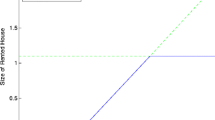Abstract
Purchasing a home involves a large and localized investment that leaves many families exposed to volatile house prices and at risk of losing their home equity. Price movements are typically not synchronized across cities, suggesting the potential for efficiency gains through risk sharing across households. In this paper, we consider the possibility of risk sharing through capital gains taxation. When full loss offset is permitted, potential gains and losses are reduced at the household level by taxation and distributed nationally, thereby allowing the tax authority to diversify away the local risks associated with owner-occupied housing. We simulate the effect of a capital gains tax with full loss offset on tenure choice and housing demand using micro-level data from the American Housing Survey, spanning ten years, from 1985 to 1995, and measures of time varying risk and return.
Similar content being viewed by others
References
Berkovec, J. and D. Fullerton. (1992). "A General Equilibrium Model of Housing, Taxes and Portfolio Choice." Journal of Political Economy 100(2), 390–429.
Caplin, A., S. Chan, C. Freeman and J. Tracy. (1997). Housing Partnerships, Cambridge: MIT Press.
Case, K. E., R. J. Shiller and A. N. Weiss. (1993). "Index-Based Futures and Options Markets in Real Estate." The Journal of Portfolio Management. 83–92.
Domar, E. D. and R. A. Musgrave. (1944). "Proportional Income Taxation and Risk-Taking." Quarterly Journal of Economics 58(3), 388–422.
Dynarski, M. and S. M. Sheffrin. (1985). "Housing Purchases and Transitory Income: A Study with Panel Data." The Review of Economics and Statistics 67(2), 195–204.
Edin, Per-Anders and P. Englund. (1991). "Moving Costs and Housing Demand." Journal of Public Economics 44(3), 229–320.
Englund, P.,M. Hwang and J. M. Quigley. (2000). "Hedging Housing Risk." Manuscript, University of California at Berkeley.
Gordon, R. H. (1985). "Taxation of Corporate Capital Income: Tax Revenues Versus Tax Distortions." The Quarterly Journal of Economics, C(l).
Hanushek, E. A. and J. M. Quigley. (1979). "The Dynamics of the Housing Market: A Stock Adjustment Model of Housing Consumption." Journal of Urban Economics 6, 90–111.
Hausman, J. A. (1981). "Exact Consumer's Surplus and Deadweight Loss." American Economic Review 71(4), 662–676.
Henderson, J. V. and Y. M. Ioannides. (1983). "A Model of Housing Tenure Choice." American Economic Review 73(1), 98–113.
Irvine, I. J. and W. A. Sills. (1998). "Measuring Consumer Curplus with Unknown Hicksian Demand." American Economic Review 88(1), 314–322.
McKenzie, George and I. Pearce. (1976). "Exact Measures of Welfare and the Cost of Living." Review of Economic Studies 43(3), 465–468.
Mossin, J. (1968). "Taxation and Risk-Taking: An Expected Utility Approach." Economica 75–82.
Poterba, J. (1992). "House-Price Dynamics: The Role of Tax Policy and Demography." American Economic Review 82(2), 23–242.
Rosen, H. S., R. T. Kenneth and Holtz-Eakin, Douglas. (1984). "Housing Tenure, Uncertainty and Taxation." Review of Economics and Statistics 66, 405–416.
Sheffrin, S. M. (1983). Rational Expectations. Cambridge University Press, Cambridge.
Slesnick, D. T. (1998). "Empirical Approaches to the Measurement of Welfare." Journal of Economic Literature XXXVI (4), 2108–2165.
Small, K. A. and H. Rosen. (1981). "Applied Welfare Economics with Discrete Choice Applications." Econometrica 49, 105–130.
Stiglitz, J. E. (1969). "The Effects of Income, Wealth, and Capital Gains Taxation on Risk-Taking." Quarterly Journal of Economics. 83(2), 263–283.
Tracy, J., H. Schneider and S. Chan. (1999). "Are Stocks Overtaking Real Estate in Household Portfolios?" Current Issues in Economics and Finance 5(5), Federal Reserve Bank of New York.
Turner, T. M. (2000). "Does Investment Risk Affect the Housing Decisions of Families?" Manuscript, Kansas State University.
Vartia, Y. O. (1983). "Efficient Methods of Measuring Welfare Change and Compensated Income in Terms of Ordinary Demand Functions." Econometrica 51(1), 79–98.
Author information
Authors and Affiliations
Rights and permissions
About this article
Cite this article
Sheffrin, S.M., Turner, T.M. Taxation and House-Price Uncertainty: Some Empirical Estimates. International Tax and Public Finance 8, 621–636 (2001). https://doi.org/10.1023/A:1011236922767
Issue Date:
DOI: https://doi.org/10.1023/A:1011236922767




